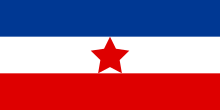
Back Republica Federal Socialista de Yugoslavia AN جمهورية يوغوسلافيا الاشتراكية الاتحادية Arabic جمهورية يوجوسلاڤيا الاشتراكيه الفيدراليه ARZ República Federativa Socialista de Yugoslavia AST Yuqoslaviya Sosialist Federativ Respublikası Azerbaijani یوقوسلاوی سوسیالیست فدراتیو جومهوریتی AZB Сацыялістычная Федэратыўная Рэспубліка Югаславія Byelorussian Социалистическа федеративна република Югославия Bulgarian Socijalistička Federativna Republika Jugoslavija BS República Federal Socialista de Iugoslàvia Catalan
Socialist Federal Republic of Yugoslavia Socijalistička Federativna Republika Jugoslavijaa Социјалистичка Федеративна Република Југославијаb Socialistična federativna republika Jugoslavija | |||||||||||||||||||
|---|---|---|---|---|---|---|---|---|---|---|---|---|---|---|---|---|---|---|---|
| 1945–1992 | |||||||||||||||||||
| Motto: Bratstvo i jedinstvo "Brotherhood and Unity" | |||||||||||||||||||
| Anthem: "Hej, Slaveni" "Hey, Slavs" | |||||||||||||||||||
 | |||||||||||||||||||
| Capital | Belgrade | ||||||||||||||||||
| Common languages | Serbo-Croatian, Slovene, and Macedonian | ||||||||||||||||||
| Government | Federal socialist republic, Single-party socialist state | ||||||||||||||||||
| President | |||||||||||||||||||
• 1945 - 1953 (first) | Ivan Ribar | ||||||||||||||||||
• 1953 - 1980 | Josip Broz Tito | ||||||||||||||||||
• 1991 - 1992 (last) | Stjepan Mesić | ||||||||||||||||||
| Prime Minister | |||||||||||||||||||
• 1945 - 1953 (first) | Josip Broz Tito | ||||||||||||||||||
• 1989 - 1991 (last) | Ante Marković | ||||||||||||||||||
| Historical era | Cold War | ||||||||||||||||||
• Established | 1945 | ||||||||||||||||||
• Constitutional reform | 21 February 1974 | ||||||||||||||||||
| 25 June 1991 - 27 April 1992 1992 | |||||||||||||||||||
| Area | |||||||||||||||||||
| July 1989 | 255,804 km2 (98,766 sq mi) | ||||||||||||||||||
| Population | |||||||||||||||||||
• July 1989 | 23,724,919 | ||||||||||||||||||
| Currency | Yugoslav dinar | ||||||||||||||||||
| Time zone | UTC+1 | ||||||||||||||||||
| Calling code | 38 | ||||||||||||||||||
| |||||||||||||||||||
a Native state name in Latin script. Latin script was used by the Serbo-Croatian language and the Slovene language. After the break up of Yugoslavia, the Serbo-Croatian language gave way to four new languages: Croatian, Bosnian, Montenegrin and Serbian. Croatian and Bosnian languages as a result use Latin script, while Serbian uses Cyrillic script. Much like Slovene, the Macedonian language that also uses Cyrillic script was independent. Identical spelling is used in both the Latin and Cyrillic versions of the state name, and in all five ex-Yugoslav languages, with the slight exception of the Slovene language. The Slovene term for the adjective "Socialist" is "Socialistična", instead of "Socijalistička". The spelling in the Serbian and Macedonian Cyrillic script transliterations of the state name (which use the Serbian Cyrillic variant) are identical to the Latin transliteration. b Native State name in Serbian Cyrillic script. In SFR Yugoslavia, Cyrillic script was used as an alternative to Latin by the Serbo-Croatian language (in SR Serbia and SR Montenegro), and the Macedonian language (in SR Macedonia). After the dissolution of Yugoslavia and the unified Serbo-Croatian language, the new Serbian language primarily uses Cyrillic script (alongside Latin). The Macedonian language language, independent during (and after) the Yugoslav period, also continued to use Cyrillic script. | |||||||||||||||||||

The Socialist Federal Republic of Yugoslavia (SFRY) was the Yugoslav country that existed from 1945 to 1992. It was a socialist state. It was also a federation made up of Bosnia and Herzegovina, Croatia, Macedonia, Montenegro, Serbia and Slovenia.
Josip Broz Tito ruled Yugoslavia until 1980. He died at that time. In June 1991 Slovenia and Croatia declared independence. By 1992 only Serbia and Montenegro still wanted a union. They made a new country called the Federal Republic of Yugoslavia. Leaders around the world didn't agree it was the same as the old Yugoslavia. Montenegro left in 2005.


